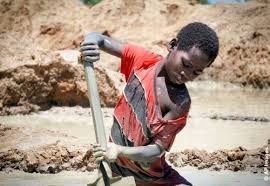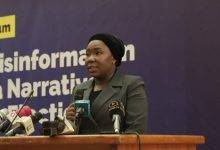
In the impoverished and dangerous world of child labour, Gyamfi’s story stands out as both heart-wrenching and hopeful. Forced to abandon his education at age 12, after death snatched his mother, he found himself embroiled in illegal mining (galamsey) in order for him and his grandmother to survive.
“I used to go to school and when lessons were over, I would run to the mining site and work into the evening. I was not making enough money to care for my family, so I had to stop going to school entirely.
“I didn’t want to be involved, but it was my only means of survival. I remember when a pit collapsed just as I was about to step in. I’ve also seen people trapped in tunnels for hours,” he recounted.
Luckily for Gyamfi (not real name), World Vision’s intervention gave him a new lease of life, after months of burdens and body aches. The NGO rescued him from the pit of poverty by helping his grandmother start a small business.
When he was ready to learn a trade, they paid for part of his enrolment fee and provided him with basic needs. Now 16 and beaming with pride, Gyamfi whose story was published by World Vision, looks to a bright future full of hope and possibilities.
Unfortunately, thousands of children across the country are enduring Gyamfi’s kind of body aches. From the agriculture, through mining and fisheries sectors and beyond, they are trapped in the vicious cycle of child labour, hoping that the government would one day find a powerful balm (solution) to bring them relief.
Child Labour
Child labour is considered to be work done by individuals below the age of 18 years that infringes upon their basic human rights. Such work is also deemed abusive, exploitative, hazardous, and detrimental to the health, safety, and development of the child, according to International Labour Organisation(ILO) Conventions 138 and 182, as well as Ghana’s Children’s Act of 1998 (Act 560).
The Act provides guidelines for minimum age requirements for different categories of work, indicating that children can engage in light work at 13 years old, normal employment at 15 years old, and hazardous work only above 18 years old. The Act also regulates the number of hours children can work on school and non-school days, and prohibits night work for children from 8 p.m. to 6 a.m.
Various types of work prohibited under Act 560 are those dangerous to children’s health, safety, and morals such as sea or fishing expeditions, mining and quarrying, porterage of heavy loads, manufacturing industries with the use of chemicals, and work in environments like bars, hotels, and other establishments with exposure to immoral activities.
Prevalence
The ILO has revealed that a staggering 160 million children around the world are still involved in child labour. Africa has the highest number of children affected by this as 72 million children are trapped in this cycle. In Ghana, the 2021 Population and Housing Census found that 419,254 children aged between 5 to 17 years were undertaking economic activities. Shockingly, 153,773 of these children have never even attended school. Despite being so young, they worked an average of 29.2 hours a week. There were 94,748 children who were both attending school and working at the same time, which highlights the difficulty of juggling education and economic responsibilities faced by these young ones.
Legal regime
Apart from Ghana being a signatory to international instruments, such as ILO Conventions 138 and 182, and the Sustainable Development Goals (SDGs), which call for the elimination of child labour, there are laws that guard against the act in the country. They include the 1992 Constitution; the Children’s Act 1998 (Act 560); the Human Trafficking Act 2005, (Act 694); the Domestic Violence Act 2007 (Act 732); the Labour Act 2003 (Act 651); the Minerals and Mining Act 2006, (Act 703) and the Child Rights Regulations 2002 (L.I. 1705).
Previous efforts
Ghana has been successful in implementing various strategies, including national action plans and other framework by the Ministry of Gender, Children and Social Protection, to tackle child labour and has made moderate progress. The first National Plan of Action (2009-2015) was aimed at minimising the worst forms of child labour and establishing strong social, policy, and institutional foundations to eradicate child labour in the long run.
The Assistant Chief Labour Officer, Esther Ofori Agyeman, explains that this resulted in greater national awareness about child labour and better coordination among public institutions, civil society, and global organisations. The NPA2 builds on these achievements and aims to reduce child labour to, at least, 10 per cent by 2021. The plan prioritised education and social protection, but like NPA 1, she says “inadequate resources did not allow us to fully achieve the set goals”.
The new balm
Despite this, Ghana is determined to sustain efforts to eliminate child labour. During the national commemoration of this year’s World Day Against Child Labour on June 12 at Ntow Krom at the Ayensuano District in the Eastern Region, a bold initiative was launched to put an end to all forms of child labour by 2025.
The Ghana Accelerated Action Plan Against Child Labour (2023- 2027) was created by state agencies with mandate on this issue with the aim of achieving the SDG target 8.7 and was developed with the support of several partners, including the International Cocoa Initiative (ICI) and UNICEF.
The comprehensive plan will address all sectors, with a particular focus on agriculture, street hawking, transportation, child domestic work and gaming and betting. Ms Agyeman provided highlights of the plan, emphasising that it builds on lessons from previous plans and serves as the guiding document for the mobilisation of duty bearers to eliminate child labour in Ghana.
She also said the core principles guiding the plan include respect for constitutional rights, responsibilities, best interest and recognition of children and their voice. Furthermore, stakeholders will engage communities, children and young people as agents of change, promoting a collaborative effort to eliminate child labour in the country.
She said structures were already in place at all levels towards the implementation of the plan, highlighting the importance of everyone’s responsibility in protecting children who are the future leaders of the nation.
The Minister of Employment and Labour Relations, Bright Wireko-Brobbey, who launched the plan, echoed this sentiment, affirming the government’s commitment to eliminating child labour and calling for collaboration.
“Together, we have the power to build a future free from child labour, a future where every child is cherished, protected and given the opportunity to thrive,” he said.
Will it bring relief ?
The launch of this bold initiative represents a significant milestone towards eliminating child labour in Ghana. It is true that it may be early days yet to assess its effectiveness but judging from the prevailing situation this plan must indeed accelerate efforts to curbing child labour.
Firstly, the plan must be executed with careful consideration of the specific nuances of each sector targeted, including agriculture, street hawking, transportation, child domestic work, and gaming and betting. It is essential to identify and address the root causes of child labour, which include poverty, lack of education and awareness, and cultural practices that condone it.
Furthermore, effective implementation of the plan requires not only the mobilisation of duty bearers but also the empowerment of children and young people as agents of change. It is essential to ensure that the voices of children are heard and their rights respected in all decision-making processes.
It is critical that all relevant agencies, organisations and individuals work together towards the goal of ending child labour in Ghana.
Adequate funding was a major barrier to achieving the goals of the previous plans. Are there specific measures in place to ensure adequate funding throughout the plan’s implementation or contingencies in case of budget cuts or reductions in funding?
ICI /CHRAJ
The Country Director ICI, Mike Arthur, is of the view that child labour is a complex and technical issue which required continuous awareness creation for people to grasp and appreciate efforts being made to eliminate it.
“…the real work is on the ground and every effort must be made to ensure that the ground work is solid, so that by 2025, when the account of SDG Goal 8.7 is given, we will have a clean balance sheet,” he said.
The Commission on Human Rights and Administrative Justice advocated recently that poverty alleviation interventions should be allocated adequate funding to make them impactful.
By implementing these, Ghana’s ‘new balm’ should be efficacious to bring relief to the thousands of Ghanaian children bearing Gyamfi’s kind of body aches across the country.
BY JONATHAN DONKOR







